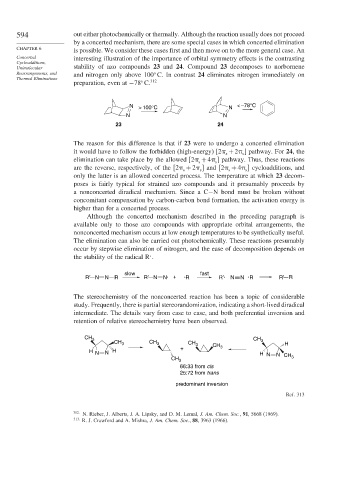Page 620 - Advanced Organic Chemistry Part B - Reactions & Synthesis
P. 620
594 out either photochemically or thermally. Although the reaction usually does not proceed
by a concerted mechanism, there are some special cases in which concerted elimination
CHAPTER 6
is possible. We consider these cases first and then move on to the more general case. An
Concerted interesting illustration of the importance of orbital symmetry effects is the contrasting
Cycloadditions,
Unimolecular stability of azo compounds 23 and 24. Compound 23 decomposes to norbornene
Rearrangements, and and nitrogen only above 100 C. In contrast 24 eliminates nitrogen immediately on
Thermal Eliminations
preparation, even at −78 C. 312
N > 100°C N < –78°C
N N
23 24
The reason for this difference is that if 23 were to undergo a concerted elimination
it would have to follow the forbidden (high-energy) 2 +2 pathway. For 24, the
s s
elimination can take place by the allowed 2 +4 pathway. Thus, these reactions
s s
are the reverse, respectively, of the 2 + 2 and 2 + 4 cycloadditions, and
s
s
s
s
only the latter is an allowed concerted process. The temperature at which 23 decom-
poses is fairly typical for strained azo compounds and it presumably proceeds by
a nonconcerted diradical mechanism. Since a C−N bond must be broken without
concomitant compensation by carbon-carbon bond formation, the activation energy is
higher than for a concerted process.
Although the concerted mechanism described in the preceding paragraph is
available only to those azo compounds with appropriate orbital arrangements, the
nonconcerted mechanism occurs at low enough temperatures to be synthetically useful.
The elimination can also be carried out photochemically. These reactions presumably
occur by stepwise elimination of nitrogen, and the ease of decomposition depends on
.
the stability of the radical R .
slow fast
R′ N N R R′ N N· + ·R R′· N N ·R R′ R
The stereochemistry of the nonconcerted reaction has been a topic of considerable
study. Frequently, there is partial stereorandomization, indicating a short-lived diradical
intermediate. The details vary from case to case, and both preferential inversion and
retention of relative stereochemistry have been observed.
CH 3 CH
CH 3 CH 3 CH 3 CH 3 H
+ 3
H N N H H N N CH
CH 3 3
66:33 from cis
25:72 from trans
predominant inversion
Ref. 313
312 N. Rieber, J. Alberts, J. A. Lipsky, and D. M. Lemal, J. Am. Chem. Soc., 91, 5668 (1969).
313
R. J. Crawford and A. Mishra, J. Am. Chem. Soc., 88, 3963 (1966).

